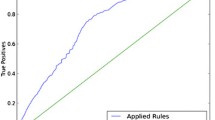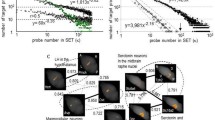Abstract
We have applied the Neuro Behavior Ontology (NBO), an ontology for the annotation of behavioral gene functions and behavioral phenotypes, to the annotation of more than 1,000 genes in the mouse that are known to play a role in behavior. These annotations can be explored by researchers interested in genes involved in particular behaviors and used computationally to provide insights into the behavioral phenotypes resulting from differences in gene expression. We developed the OntoFUNC tool and have applied it to enrichment analyses over the NBO to provide high-level behavioral interpretations of gene expression datasets. The resulting increase in the number of gene annotations facilitates the identification of behavioral or neurologic processes by assisting the formulation of hypotheses about the relationships between gene, processes, and phenotypic manifestations resulting from behavioral observations.

Similar content being viewed by others
References
Adam D (2013) Mental health: on the spectrum. Nature 496(7446):416–418
Amberger J, Bocchini C, Hamosh A (2011) A new face and new challenges for online mendelian inheritance in man (OMIM). Hum Mutat 32:564–567
Ashburner M, Ball CA, Blake JA, Botstein D, Butler H, Cherry MJ, Davis AP, Dolinski K, Dwight SS, Eppig JT, Harris MA, Hill DP, Tarver LI, Kasarskis A, Lewis S, Matese JC, Richardson JE, Ringwald M, Rubin GM, Sherlock G (2000) Gene ontology: tool for the unification of biology. Nat Genet 25(1):25–29
Blake JA, Bult CJ, Kadin JA, Richardson JE, Eppig JT, Mouse Genome Database Group (2011) The mouse genome database (MGD): premier model organism resource for mammalian genomics and genetics. Nucleic Acids Res 39(suppl 1):D842–D848
Brown SD, Moore MW (2012) Towards an encyclopedia of mammalian gene function: the international mouse phenotyping consortium. Dis Model Mech 5(3):289–292
Bult CJ, Eppig JT, Kadin JA, Richardson JE, Blake JA (2008) The mouse genome database (MGD): mouse biology and model systems. Nucleic Acids Res 36:D724–D728
Chesler EJ, Wilson SG, Lariviere WR, Rodriguez-Zas SL, Mogil JS (2002) Influences of laboratory environment on behavior. Nate Neurosci 5(11):1101–1102
Chesler E, Lu L, Wang J, Williams R, Manly K (2004) WebQTL: rapid exploratory analysis of gene expression and genetic networks for brain and behavior. Nat Neurosci 7:485–486
Collaborative C. C. (2012) The genome architecture of the collaborative cross mouse genetic reference population. Genetics 190(2):389–401
Cooper SJ (1981) Behaviourally-specific hyperdipsia in the non-deprived rat following acute morphine treatment. Neuropharmacology 20(5):469–472
Craddock N, Owen MJ (2010) The kraepelinian dichotomy—going, going…but still not gone. Br J Psychiatr 196(2):92–95
Cross-Disorder Group of the Psychiatric Genomics Consortium, Smoller JW, Craddock N, Kendler K, Lee PH, Neale BM, Nurnberger JI, Ripke S, Santangelo S, Sullivan PF (2013) Identification of risk loci with shared effects on five major psychiatric disorders: a genome-wide analysis. Lancet 381(9875):1371–1379
Davis S, Meltzer P (2007) Geoquery: a bridge between the gene expression omnibus (geo) and bioconductor. Bioinformatics 14:1846–1847
de Mooij-van Malsen AJG, Vinkers CH, Peterse DP, Olivier B, Kas MJH (2011) Cross-species behavioural genetics: a starting point for unraveling the neurobiology of human psychiatric disorders. Prog Neuropsychopharmacol Biol Psychiatr 35(6):1383–1390
Devos R, Richards JG, Campfield LA, Tartaglia LA, Guisez Y, van der Heyden J, Travernier J, Plaetinck G, Burn P (1996) OB protein binds specifically to the choroid plexus of mice and rats. Proc Natl Acad Sci USA 93(11):5668–5673
Enquist J, Ferwerda M, Milan-Lobo L, Whistler JL (2012) Chronic methadone treatment shows a better cost/benefit ratio than chronic morphine in mice. J Pharmacol Exp Ther 340(2):386–392
Gkoutos GV, Green EC, Mallon A-M, Hancock J, Davidson D (2004) Using ontologies to describe mouse phenotypes. Genome Biol 6(1):R8
Gkoutos GV, Schofield PN, Hoehndorf R (2012) The neurobehavior ontology: an ontology for annotation and integration of behavior and behavioral phenotypes. In: Chesler EJ, Haendel MA (eds) Bioinformatics of behavior: Part 1, volume 103 of international review of neurobiology, chap 4. Academic Press, Waltham, pp 69–87
Gottesman II, Gould TD (2003) The endophenotype concept in psychiatry: etymology and strategic intentions. Am J Psychiatr 160(4):636–645
Gould TD, Gottesman I (2006) Psychiatric endophenotypes and the development of valid animal models. Genes Brain Behav 5(2):113–119
Grau B, Horrocks I, Motik B, Parsia B, Patelschneider P, Sattler U (2008) OWL 2: the next step for OWL. Web Semant 6(4):309–322
Gu C, Li P, Hu B, Ouyang X, Fu J, Gao J, Song Z, Han L, Ma Y, Tian S, Hu X (2008) Chronic morphine selectively impairs cued fear extinction in rats: implications for anxiety disorders associated with opiate use. Neuropsychopharmacology 33:666–673
Hoehndorf R, Dumontier M, Gkoutos GV (2012) Evaluation of research in biomedical ontologies. Brief Bioinform. doi:10.1093/bib/bbs053
Hoehndorf R, Hardy NW, Osumi-Sutherland D, Tweedie S, Schofield PN, Gkoutos GV (2013) Systematic analysis of experimental phenotype data reveals gene functions. PLoS One 8(4):e60847
Horridge M, Bechhofer S, Noppens O (2007) Igniting the OWL 1.1 touch paper: The OWL API. In: proceedings of OWLED 2007: third international workshop on OWL Experiences and Directions. http://webont.org/owled/2007/PapersPDF/submission_32.pdf
Horrocks I (2007) OBO flat file format syntax and semantics and mapping to OWL web ontology language. Technical report, University of Manchester. http://www.cs.man.ac.uk/~horrocks/obo/
Jakubcakova V, Flachskamm C, Landgraf R, Kimura M (2012) Sleep phenotyping in a mouse model of extreme trait anxiety. PLoS One 7(7):e40625
Kapur S, Phillips AG, Insel TR (2012) Why has it taken so long for biological psychiatry to develop clinical tests and what to do about it? Mol Psychiatr 17:1174–1179
Karp NA, Melvin D, Sanger Mouse Genetics Project, Mott RF (2012) Robust and sensitive analysis of mouse knockout phenotypes. PLoS One 7(12):e52410
Kas MJ, Fernandes C, Schalkwyk LC, Collier DA (2007) Genetics of behavioural domains across the neuropsychiatric spectrum; of mice and men. Mol Psychiatr 12(4):324–330
Kas MJ, Gelegen C, Schalkwyk LC, Collier DA (2009) Interspecies comparisons of functional genetic variations and their implications in neuropsychiatry. Am J Med Genet B 150B(3):309–317
Kas MJ, Krishnan V, Gould TD, Collier DA, Olivier B, Leach KP, Domenici E, Fuchs E, Gross C, Castren E (2011a) Advances in multidisciplinary and cross-species approaches to examine the neurobiology of psychiatric disorders. Eur Neuropsychopharmacol 21(7):532–544
Kas MJ, Kahn RS, Collier DA, Waddington JL, Ekelund J, Porteous DJ, Schughart K, Hovatta I (2011b) Translational neuroscience of schizophrenia: seeking a meeting of minds between mouse and man. Sci Transl Med 3(102):102mr3
Kazakov Y, Krötzsch M, Simančík F (2011) Unchain my EL reasoner. In: Haarslev V, Toman D, Weddell G (eds), Proceedings of the 23rd International Workshop on Description Logics (DL-2010), Waterloo, Canada, May 4–7, 2010. CEUR Workshop Proceedings. http://ceur-ws.org/Vol-573/
Korostynski M, Piechota M, Kaminska D, Solecki W, Przewlocki R (2007) Morphine effects on striatal transcriptome in mice. Genome Biol 8(6):R128
Kumar T, Jha SK (2012) Sleep deprivation impairs consolidation of cued fear memory in rats. PLoS One 7(10):e47042
Lichtenstein P, Carlstrom E, Rastam M, Gillberg C, Anckarsater H (2010) The genetics of autism spectrum disorders and related neuropsychiatric disorders in childhood. Am J Psychiatr 167(11):1357–1363
Mackay TF, Anholt RR (2007) Ain’t misbehavin’? genotype-environment interactions and the genetics of behavior. Trends Genet 23(7):311–314
Mackiewicz M, Shockley KR, Romer MA, Galante RJ, Zimmerman JE, Naidoo N, Baldwin DA, Jensen ST, Churchill GA, Pack AI (2007) Macromolecule biosynthesis: a key function of sleep. Physiol Genomics 31(3):441–457
Mungall CJ, Gkoutos GV, Smith CL, Haendel M, Lewis S, Ashburner M (2010) Integrating phenotype ontologies across multiple species. Genome Biol 11(1):R2
Nestler EJ, Hyman SE (2010) Animal models of neuropsychiatric disorders. Nat Neurosci 13(10):1161–1169
Ojanen SP, Hyytiä P, Kiianmaa K (2005) Behavioral sensitization and voluntary ethanol drinking in alcohol-preferring AA rats exposed to different regimens of morphine treatment. Pharmacol Biochem Behav 80(2):221–228
Oti M, Brunner HG (2006) The modular nature of genetic diseases. Clin Genet 71(1):1–11
Prüfer K, Muetzel B, Do HH, Weiss G, Khaitovich P, Rahm E, Paabo S, Lachmann M, Enard W (2007) FUNC: a package for detecting significant associations between gene sets and ontological annotations. BMC Bioinformatics 8:41
Ramaswamy S, Venkatadri N, Bapna JS (1987) An investigation into the possible development of chronic tolerance to analgesia and dependence on prolactin. Fundam Clin Pharmacol 1(6):445–449
Richter SH, Garner JP, Auer C, Kunert J, Wrbel H (2010) Systematic variation improves reproducibility of animal experiments. Nat Methods 7:167–168
Robinson PN, Koehler S, Bauer S, Seelow D, Horn D, Mundlos S (2008) The human phenotype ontology: a tool for annotating and analyzing human hereditary disease. Am J Hum Genet 83(5):610–615
Silva RH, Kameda SR, Carvalho RC, Takatsu-Coleman AL, Niigaki ST, Abilio VC, Tufik S, Frussa-Filho R (2004) Anxiogenic effect of sleep deprivation in the elevated plus-maze test in mice. Psychopharmacology 176(2):115–122
Smith CL, Goldsmith CA, Eppig JT (2004) The mammalian phenotype ontology as a tool for annotating, analyzing and comparing phenotypic information. Genome Biol 6(1):R7
Subramanian A, Tamayo P, Mootha VK, Mukherjee S, Ebert BL, Gillette MA, Paulovich A, Pomeroy SL, Golub TR, Lander ES, Mesirov JP (2005) Gene set enrichment analysis: a knowledge-based approach for interpreting genome-wide expression profiles. Proc Natl Acad Sci USA 102(43):15545–15550
Weiser M, van Os J, Davidson M (2005) Time for a shift in focus in schizophrenia: from narrow phenotypes to broad endophenotypes. Br J Psychiatr 187:203–205
Würbel H, Richter SH, Garner JP (2013) Reply to: “reanalysis of Richter et al. (2010) on reproducibility”. Nat Methods 10(5):374
Acknowledgments
RH was supported by the European Commission’s 7th Framework Programme, RICORDO Project (Grant No. 248502). RH, PNS, and GVG were supported by the National Institutes of Health (Grant No. R01 HG004838-02).
Author information
Authors and Affiliations
Corresponding authors
Rights and permissions
About this article
Cite this article
Hoehndorf, R., Hancock, J.M., Hardy, N.W. et al. Analyzing gene expression data in mice with the Neuro Behavior Ontology. Mamm Genome 25, 32–40 (2014). https://doi.org/10.1007/s00335-013-9481-z
Received:
Accepted:
Published:
Issue Date:
DOI: https://doi.org/10.1007/s00335-013-9481-z




